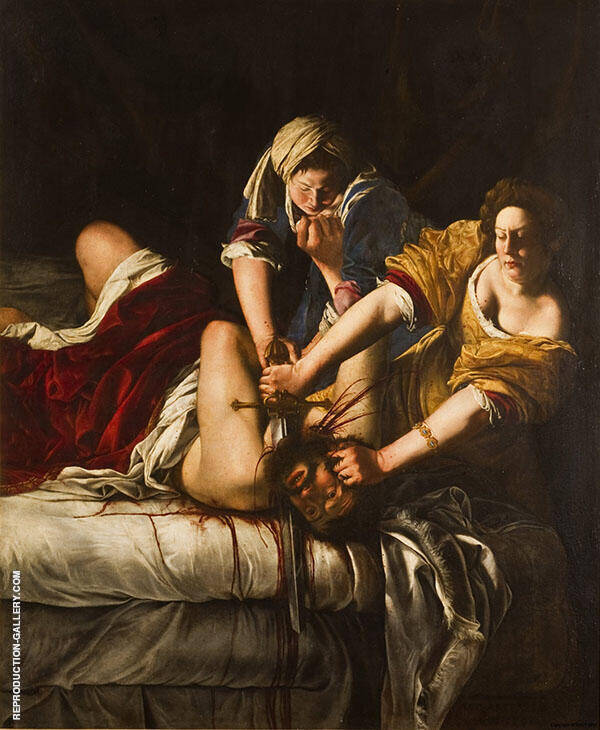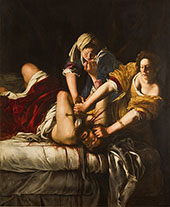Judith Slaying Holofernes 1614 By Artemisia Gentileschi
Judith Slaying Holofernes by Artemisia Gentileschi depicts a story from the apocryphal Book of Judith (from the Old Testament). This Baroque oil painting represents the assassination of the great Assyrian general Holofernes with Judith (the Israelite heroine of the narrative) performing the murder.
Gentileschi’s painting depicts the exact moment she severs Holofernes’ neck. Then, assisted by her maidservant (Abra), Judith beheads Holofernes while he sleeps in a deep, drunken slumber.
When did Artemisia Gentileschi paint Judith Slaying Holofernes?
While the dating of the painting remains uncertain, scholars believe that Gentileschi created one of the most famous religious paintings sometime between 1612 and 1614. But, intriguingly, Gentileschi also made another version of the artwork, likely painted in 1620.
The second version currently hangs in the Uffizi Gallery in Florence. The original artwork resides at the Museo Capodimonte, Naples.
Gentileschi created Judith Slaying Holofernes to illustrate the biblical story of the assassination of the Assyrian general Holofernes. The painting depicts the pivotal point of the story when the actual beheading occurs.
Despite being one of the most famous religious paintings, the artwork is unabashedly physical. Indeed, Gentileschi portrays the wide spurts of blood coming from Holofernes' neck and onto the crisp white sheets.
The women’s strong effort is plain to see. Judith grasps Holofernes’ hair while Abra holds the large man down. Abra’s petite size contrasts with his large hand, desperately struggling against her red dress. His eyes glaze past the viewer, half in desperation, half already in the throes of death.
Both women have their sleeves rolled up as if hard at work. The primary color of their dresses contrasts strongly with the dark background. As a keen follower of Caravaggio, Gentileschi utilizes chiaroscuro to significant effect, with light directly illuminating the faces of the three protagonists.
Gentileschi was almost twenty years old when she painted Judith Slaying Holofernes. Previous Artemisia Gentileschi artworks included Susanna and the Elders and Salome with the Head of Saint John the Baptist. Yet, even with these early Artemisia Gentileschi artworks, her astounding painterly skill was evident.
What is the story behind Judith and Holofernes?
Aside from the biblical narrative, many art historians read a deeper personal meaning into Gentileschi's painting, Judith Slaying Holofernes. It fits with the broader tradition of Artemisia Gentileschi paintings depicting strong women.
The painting could also be a form of “visual revenge” from the artist. Raped in 1611 by Agostino Tassi (a fellow Italian painter), it could represent Gentileschi’s anger against the male sex.
Previously accused of raping his sister-in-law, one of his wives, and attempting to murder his present wife, Tassi only received a two-year sentence. However, the Court annulled Tassi's guilty verdict, and by 1613 (the likely date of this painting), he was at liberty again.
Consequently, many scholars link the painting to the “power of women” theme, including womanly wiles, the trials and tribulations of marriage, and female domination over men. In Gentileschi’s painting, Judith is a fiercely beautiful woman, enticing Holofernes to his eventual doom.
What was unusual about Gentileschi's famous religious painting?
Renaissance painters frequently depicted this fascinating biblical narrative. Yet, despite this, Gentileschi’s painting of Judith Slaying Holofernes stands out for its pure physicality and emotional impact.
Of course, it is also unusual for its female author. Amongst the great painters tackling the theme, including Titian, Peter Paul Rubens, and Rembrandt, Gentileschi was the only woman to depict this iconic scene.
Many large Renaissance oil paintings on canvas (created by some of the most famous artists of all time) represented Judith in her endeavors. For instance, Lucas Cranach the Elder painted Judith with the Head of Holofernes (c.1520-40). However, in this version, there is no vividly gushing blood. Instead, the act of beheading has already taken place.
Donatello also created a sculpture of the act, with Judith towering over Holofernes’ body (sword in hand), just about to undertake the deed. In this version, Holofernes strongly represented the sin of arrogance. Indeed, Donatello’s inscription reads, “Behold the neck of pride.”
Unlike Donatello, Gentileschi doesn’t foreground Holofernes’ sin but highlights Judith’s moment of violent triumph. More directly comparable is Caravaggio’s Judith Beheading Holofernes (1599), which similarly utilizes strong chiaroscuro and spurting blood. Deeply inspired by Caravaggio, Gentileschi likewise foregrounds the scene's dramatic features and human conflict.
Ultimately, Judith Slaying Holofernes by Artemisia Gentileschi remains one of the most striking and extraordinary representations of this biblical scene ever created.
Our extensive online catalog features many art reproductions of famous paintings. In addition, our Art Collection of famous religious paintings displays a beautiful selection of fine art oil paintings in many sizes.
We offer a 100% money back guarantee or replacement service. If for any reason you are dissatisfied with your painting please contact us within 7 days of receipt, advising the reason you are unhappy and we will provide you with all the information you need for its return or replacement.
We ship free to anywhere in the world via FedEx or DHL expedited service with online tracking.
Your painting will be shipped rolled in strong plastic tubing, ready for stretching and/or framing locally. This is the conventional method of transporting hand-painted oil on canvas. Learn more about how your painting is shipped.
We are able to offer a framing service intercontinental U.S. Please contact us if you would like a quotation. Alternatively, should you prefer, we can recommend a framer in your area.
Notes About Your Painting
Please note that replica oil paintings are finished with an additional 10cm (4") of extra canvas on all sides, allowing ample surplus canvas for stretching and framing.
Recently Viewed:
Cannot Find What You Are Looking For?
Reproduction Gallery Information
Customer Service
(Send Us A Message)
Tel: (503) 937 2010
Fax: (503) 937 2011







